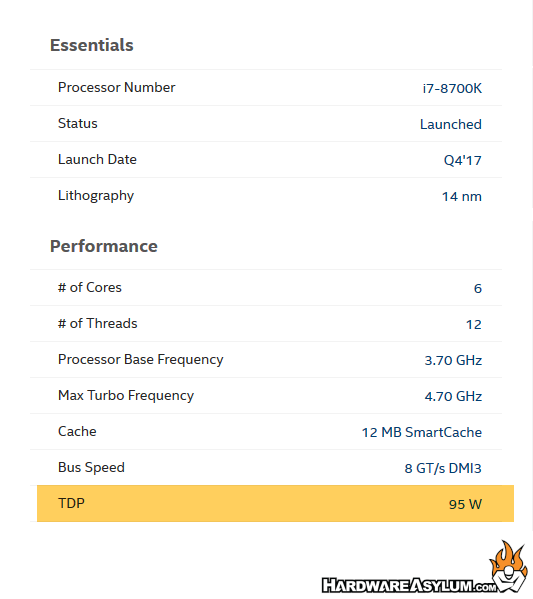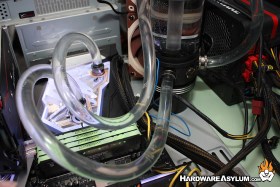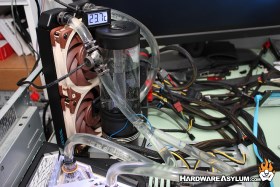Aorus Z390 Xtreme Waterforce Motherboard Review
Author: Dennis GarciaXtreme Waterforce AIO Monoblock Testing
The Aorus Z390 Xtreme Waterforce Monoblock is designed for Intel Socket LGA1151 and the Z390 Xtreme Waterforce motherboard. This is an AIO watercooling solution designed to cool the CPU, Chipset and VRM from a single loop. Here is an overview of the system and testing methodology.
Aorus Z390 Xtreme Waterforce – Z390 Chipset
Intel Core i7 8700k – Stock without a delid
Alphacool 240mm Radiator (dual 120mm fans)
2x Noctua NF-A12x25 Fans. PWM controlled at 50% RPM
D5 Pump
XSPC X4 Photon 170 Reservoir
XSPC 7/16” OD Soft Compression fittings
Tygon 7/16” Tubing
Water temp and ambient thermal monitoring inline from the outlet of the monoblock, K-Type probe inside the reservoir and at the intake of the radiator
The CPUID System Monitor was used to obtain and record system temperature data and being that this is a quad core processor we need something that will work across all of the cores at once. For this task we're using a new version of Prime95 (p95v255a) that will allow you to spawn (n) instances to test with.

Editors note: Even though the Windows 10 task manager reported 100% processor usage we could never attain a 100% of the rated heat output as documented by Intel (see below) when using Prime95 as a basis for that heat production. Knowing this we ran the stress test until the maximum temperature was attainted and stabilized.
Other things to consider when judging software induced heat output.
a) Clock throttling by the processor at high temperatures.
b) Normal software isn't designed to produce maximum heat output.
c) Variances of cooling temperature.
d) Variances in CPU load.
e) Inaccuracies in thermal diode readouts.
Of course the list goes on..
Given that Core i7 8700K processors are not soldered the CPU temp will register higher than they should be. This is due to thermal transfers between the CPU Die and the Heatspreader though a very robust and not very efficient TIM applied at the factory. However, given that this and may other factors in this cooling loop are standards they can be used for comparison.
Our testing methodology is aimed to provide a real world look into this heatsink given the test system provided.

A C/W rating can quickly be calculated using this formula.
C/W = (CPU temp - Ambient temp)/(Variance(%) * CPU Watts)
Allowed variance for this test = 85%
CPU Watts = 95W
0.41 C/W = (55C - 22C)/(.85(95W)) – Air Temp
0.36 C/W = (55C - 26C)/(.85(95W)) – Water Temp
For this next test the CPU speed was cranked up to 4.9Ghz and the test was re-run

To calculate a new C/W rating for this test we will need to factor in the increased processor wattage. The formula and constants for this are listed below.
ocC/W = dCPU Watts * (ocMhz / dMhz) * (ocVcore / dVcore)2
ocMhz = 4900
dMhz = 3700
ocVcore = 1.3
dVcore = 1.14
The variance still applies for our C/W calculation
Allowed variance for this test = 85%
CPU Watts = 163W
0.34 C/W = (69C - 22C)/(.85(163W)) – Air Temp
0.30 C/W = (69C - 27C)/(.85(163W)) – Water Temp
In our heatsink and waterblock tests we don't really focus on overall load temperatures but rather how well the product can remove heat given a specified heat load. Since this is a real world testing method we need to take into consideration real world variables and estimate tolerances. This is why we normally only apply 85% of the total wattage output to our heat calculations.
The resulting C/W number is used to rate how efficient a heatsink or waterblock is based on the given heat load. These numbers can be used to determine heat capacity, the larger the difference the less efficient the heatsink is. (aka not good for overclocking)
It is not uncommon to see an increase in thermal capacity when using watercooling and is due to how much heat water can move from one location to another. This is indicated by the C/W number being lower between the tests and there are two ways to look at this. The first, and most obvious, is that you have to look at things such as fan speed and ambient temperature.
There are two ambient temperatures to factor in.
- Air Temp measures the ambient of air so the end result factors in the radiator.
- Water Temp is the real ambient for waterblock testing and uses the temperature of the water.
In both instances the Aorus Monoblock performed wonderfully and would expect slightly better C/W numbers when using a 9000 series soldered processor.
Keep in mind these calculations are provided for demonstration purposes only and may not reflect the actual lab tested C/W rating, but we're pretty close.



